Power electronic handbook
Подождите немного. Документ загружается.

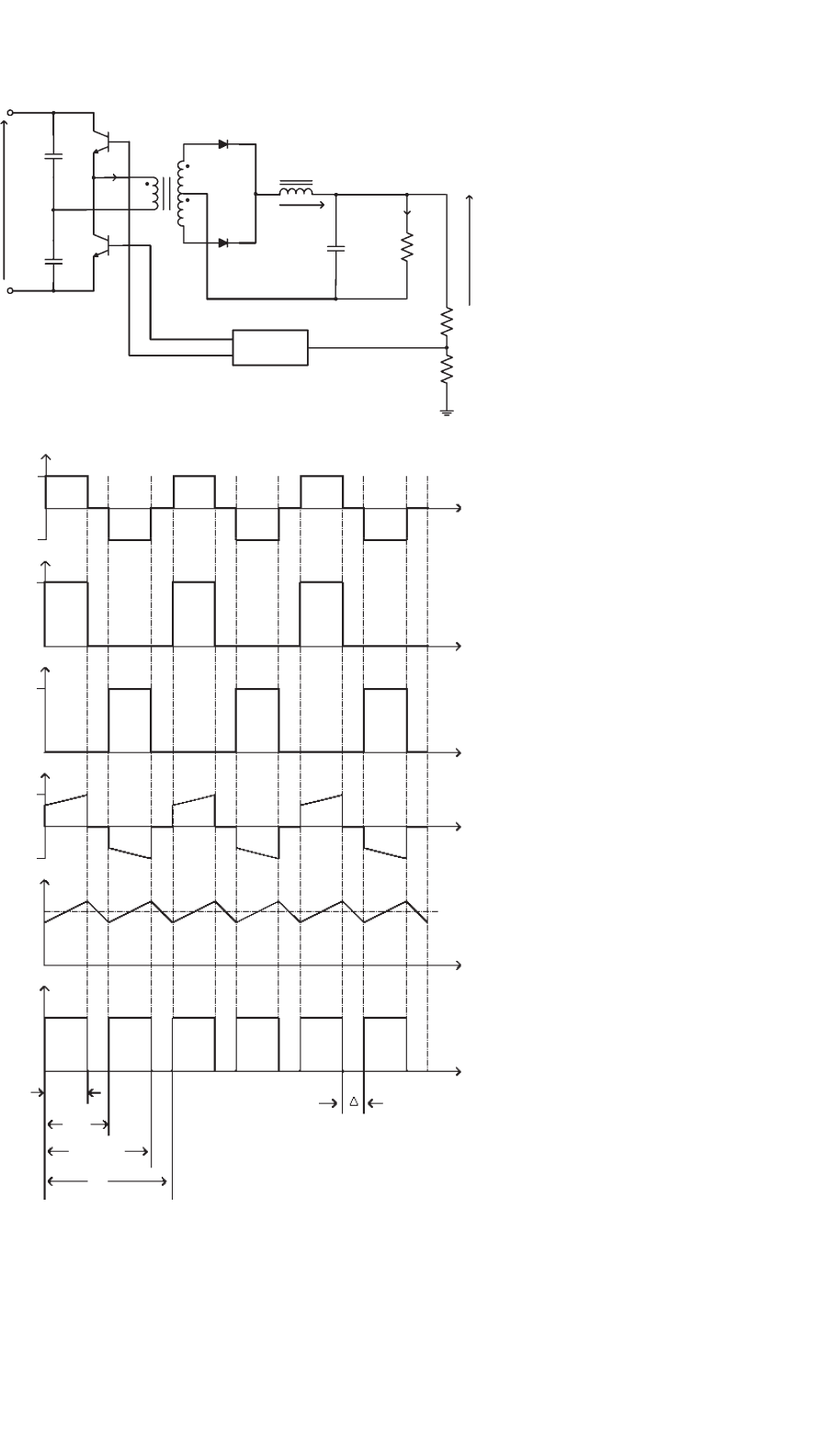
612 Y. M. Lai
C
F
V
x
V
i
R
L
I
L
I
L1
L
1
R
2
V
o
R
1
D
R1
D
R2
N
s1
N
s2
V
p
V
Q1
V
Q2
I
p
I
L1
V
x
V
i
/2
−V
i
/2
0
I
p(pk)
−I
p(pk)
V
i
V
i
N
p
V
p
I
p
C
1
C
2
Q
2
Q
1
Control
0
0
0
0
0
DT
T/2
T/2+DT
T
t
t
I
L
t
t
t
t
+
+
−
−
(a)
(b)
FIGURE 23.26 A simplified half-bridge regulator: (a) circuit and (b) the associated waveforms.

23 Power Supplies 613
Note that the multiplier of 2 appears in Eq. (23.66) because
of the two alternate half cycles. Solving Eq. (23.66) for V
o
,
we have
V
o
=
N
s1
N
p
V
i
D (23.67)
The output power P
o
is given by
P
o
= V
o
I
L
= ηP
in
= η
V
i
I
p(avg)
D
2
(23.68)
or
I
p(avg)
=
2P
o
ηV
i
D
(23.69)
where I
p(avg)
has the value of the primary current at the center
of the rising or falling ramp. Assuming the reaction current
I
p
reflected from the secondary is much greater than the mag-
netizing current, then the maximum collector currents for Q
1
and Q
2
are given by
I
C(max)
= I
p(avg)
=
2P
o
ηV
i
D
max
(23.70)
As mentioned, the maximum collector voltages for Q
1
and
Q
2
at turn off are given by
V
C(max)
= V
i(max)
(23.71)
In designing half-bridge regulators, the maximum duty cycle
can never be greater than 50%. When both the transistors
are switched on simultaneously, the input voltage is short-
circuited to ground. The series capacitors C
1
and C
2
provide
a dc bias to balance the volt–second integrals of the two
switching intervals. Hence, any mismatch in devices would
not easily saturate the core. However, if such a situation arises,
a small coupling capacitor can be inserted in series with the
primary winding. A dc bias voltage proportional to the volt–
second imbalance is developed across the coupling capacitor.
This balances the volt–second integrals of the two switching
intervals.
One problem in using half-bridge regulators is related to
the design of the drivers for the power switches. Specifically,
the emitter of Q
1
is not at ground level, but is at a high ac
level. The driver must therefore be referenced to this ac level.
Typically, transformer-coupled drivers are used to drive both
switches, thus solving the grounding problem and allowing the
controller to be isolated from the drivers.
The half-bridge regulator is widely used for medium-power
applications. Because of its core-balancing feature, the half-
bridge becomes the predominant choice for output power
ranging from 200 to 400 W. Since the half-bridge is more
complex, for application below 200 W, the flyback or forward
regulator is considered to be a better choice and more cost-
effective. Above 400 W, the primary and switch currents of the
half-bridge become very high. Thus, it becomes unsuitable.
23.5.4 Full-bridge Regulators
The full-bridge regulator is yet another form of isolated for-
ward regulator. Its performance is improved over that of the
half-bridge regulator because of the reduced peak collector
current. The two series capacitors that appeared in half-bridge
circuits are now replaced by another pair of transistors of the
same type. In each switching interval, two of the switches are
turned on and off simultaneously such that the full input volt-
age appears at the primary winding. The primary and the
switch currents are only half that of the half-bridge for the
same power level. Thus, the maximum output power of this
topology is twice that of the half-bridge.
Figure 23.27 shows the basic configuration of a full-bridge
regulator and the associated steady-state waveforms. Four
power switches are required in the circuit. The power switches
Q
1
and Q
4
turn on and off simultaneously in one of the half
cycles. Q
2
and Q
3
also turn on and off simultaneously in the
other half cycle, but with opposite phase as Q
1
and Q
4
. This
produces a square-wave ac with a value of ±V
i
at the primary
winding of the transformer. Like the half-bridge, this voltage
is stepped down, rectified, and then filtered to produce a dc
output voltage. The capacitor C
1
is used to balance the volt-
second integrals of the two switching intervals and prevent the
transformer from being driven into saturation.
Under steady-state conditions, the operation of the full-
bridge is similar to that of the half-bridge. When Q
1
and Q
4
turn on, the voltage across the secondary winding is
V
s1
=
N
s1
N
p
V
i
(23.72)
Neglecting diode voltage drops and losses, the voltage across
the output inductor is then given by
V
L1
=
N
s1
N
p
V
i
−V
o
(23.73)
In this interval, the inductor current I
L1
increases linearly at
the rate of
dI
L1
dt
=
V
L1
L
1
=
1
L
1
N
s1
N
p
V
i
−V
o
(23.74)
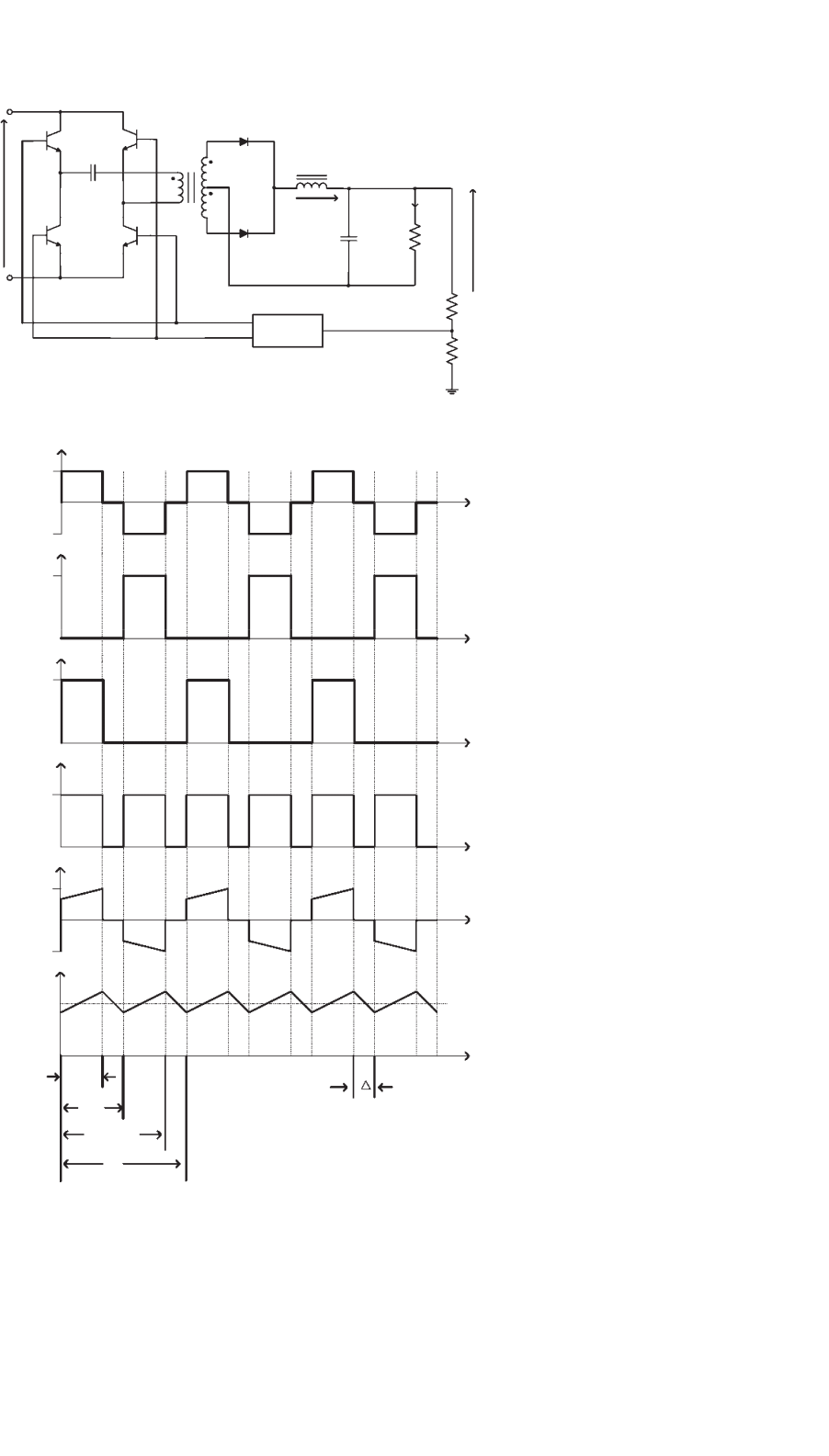
614 Y. M. Lai
C
F
V
x
V
i
R
L
I
L
I
L1
L
1
R
2
V
o
R
1
D
R1
D
R2
N
s1
N
s2
V
p
V
Q1
,V
Q4
V
Q2
,V
Q3
V
x
I
p
I
L1
I
L
V
i
−V
i
0
V
i
(N
p
/N
s
)
I
p(pk)
V
i
V
i
N
p
V
p
C
1
Q
4
Q
2
Q
3
Q
1
Control
0
0
0
0
0
DT
T/2
T/2+DT
T
t
t
I
L
t
t
t
t
+
+
−
−
(a)
(b)
FIGURE 23.27 A simplified full-bridge regulator: (a) circuit and (b) the associated waveforms.

23 Power Supplies 615
At the end of Q
1
and Q
4
on-time, I
L1
reaches a value which
is given by
I
L1(pk)
= I
L1
(0) +
1
L
1
N
s1
N
p
V
i
−V
o
DT (23.75)
During the interval , I
L1
decreases linearly at the rate of
dI
L1
dt
=
V
o
L
1
(23.76)
The next half cycle repeats with Q
2
and Q
3
on and the circuit
operates in a similar manner as in the first half cycle.
Again, as in the half-bridge, the output voltage can be found
from the time integral of the inductor voltage over a time equal
toT. Thus, we have
V
o
= 2 ×
1
T
DT
0
N
s1
N
p
V
i
−V
o
dt +
T
/
2
+DT
T
/
2
−V
o
dt
(23.77)
Solving Eq. (23.77) for V
o
, we have
V
o
=
N
s1
N
p
2V
i
D (23.78)
The output power P
o
is given by
P
o
= ηP
in
= ηV
i
I
p(avg)
D
(23.79)
or
I
p(avg)
=
P
o
ηV
i
D
(23.80)
where I
p(avg)
has the same definition as in the half-bridge case.
Comparing Eq. (23.80) with Eq. (23.69), we see that the
output power of a full-bridge is twice that of a half-bridge
with same input voltage and current. The maximum collector
currents for Q
1
,Q
2
,Q
3
, and Q
4
are given by
I
C(max)
= I
p(avg)
=
P
o
ηV
i
D
max
(23.81)
Comparing Eq. (23.81) with Eq. (23.70), for the same output
power, the maximum collector current is only half that of the
half-bridge.
As mentioned, the maximum collector voltage for Q
1
and
Q
2
at turn off is given by
V
C(max)
= V
i(max)
(23.82)
The design of the full-bridge is similar to that of the half-
bridge. The only difference is the use of four power switches
instead of two in the full-bridge. Therefore, additional drivers
are required by adding two more secondary windings in the
pulse transformer of the driving circuit.
For high power applications ranging from several hundred
to thousand kilowatts, the full-bridge regulator is an inevitable
choice. It has the most efficient use of magnetic core and
semiconductor switches. The full-bridge is complex and there-
fore expensive to build, and is only justified for high-power
applications, typically over 500 W.
23.5.5 Control Circuits and Pulse-width
Modulation
In previous subsections, we presented several popular voltage
regulators that may be used in a switching mode power supply.
This section discusses the control circuits that regulate the
output voltage of a switching regulator by constantly adjusting
the conduction period t
on
or duty cycle d of the power switch.
Such adjustment is called pulse-width modulation (PWM).
The duty cycle is defined as the fraction of the period during
which the switch is on, i.e.
d =
t
on
T
=
t
on
t
on
+t
off
(23.83)
where T is the switching period, i.e. t
off
= T −t
on
. By adjusting
either t
on
or t
off
, or both, d can be modulated. Thus, PWM
controlled regulators can operate at variable frequency as well
as fixed frequency.
Among all types of PWM controllers, the fixed frequency
controller is by far the most popular choice. There are
two main reasons for their popularity. First, low-cost fixed-
frequency PWM IC controllers have been developed by various
solid-state device manufacturers, and most of these IC con-
trollers have all the features that are needed to build a
PWM switching power supply using a minimum number
of components. Second, because of their fixed-frequency
nature, fixed-frequency controllers do not have the prob-
lem of unpredictable noise spectrum associated with vari-
able frequency controllers. This makes EMI control much
easier.
There are two types of fixed-frequency PWM controllers,
namely, the voltage-mode controller and the current-mode
controller. In its simplified form, a voltage-mode controller
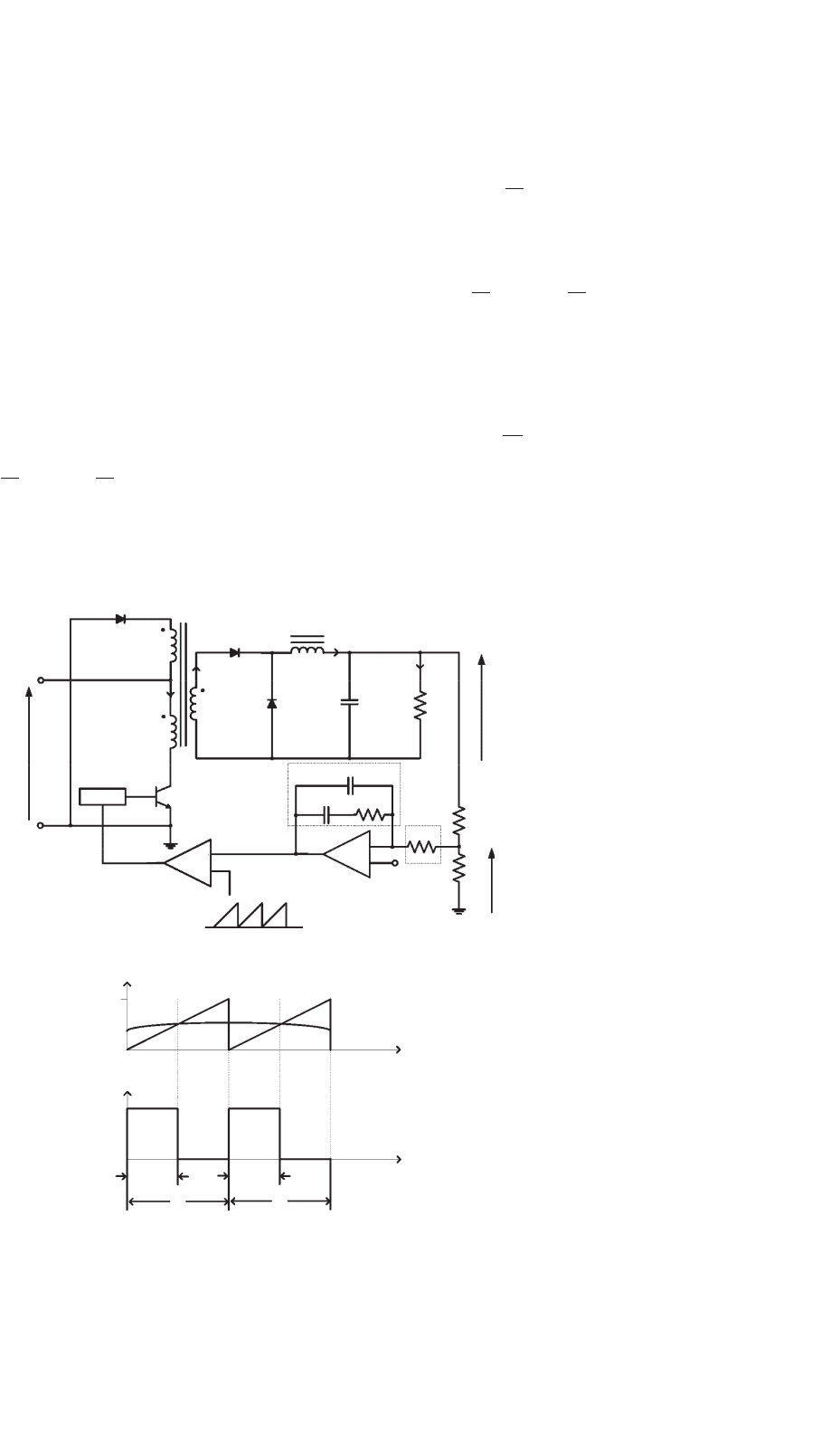
616 Y. M. Lai
consists of four main functional components: an adjustable
clock for setting the switching frequency, an output voltage
error amplifier for detecting deviation of the output from the
nominal value, a ramp generator for providing a sawtooth sig-
nal that is synchronized to the clock, and a comparator that
compares the output error signal with the sawtooth signal. The
output of the comparator is the signal that drives the controlled
switch. Figure 23.28 shows a simplified PWM voltage-mode
controlled forward regulator operating at fixed frequency and
its associated driving signal waveform. As shown, the duration
of the on-time t
on
is determined by the time between the reset
of the ramp generator and the intersection of the error voltage
with the positive-going ramp signal.
The error voltage v
e
is given by
v
e
=
1 +
Z
2
Z
1
V
REF
−
Z
2
Z
1
v
2
(23.84)
D
R1
D
R2
D
R3
N
s
V
s
L
1
I
L1
I
s
I
p
N
p
Q
1
V
Q1
PWM output
Driving signal
D
1
T
TT
D
2
T
Driver
Error voltage V
e
Comp
Sawtooth
Sawtooth
0
V
p
V
e
t
t
Error amplifier
V
REF
Z
1
Z
2
R
11
R
1
R
2
R
21
C
22
C
21
v
2
N
r
V
p
+
+
+
+
+
−
−
−
−
−
V
r
+
−
I
L
R
L
C
F
V
o
V
i
(a)
(b)
FIGURE 23.28 A simplified voltage-mode controlled forward regulator: (a) circuit and (b) the associated driving signal waveform.
From Eq. (23.84), the small-signal term can be separated
from the dc operating point by
v
e
=−
Z
2
Z
1
v
2
(23.85)
The dc operating point is given by
V
e
=
1 +
Z
2
Z
1
V
REF
−
Z
2
Z
1
V
2
(23.86)
Inspecting the waveform of the sawtooth and the error
voltage shows that the duty cycle is related to the error
voltage by
d =
v
e
V
p
(23.87)
where V
p
is the peak voltage of the sawtooth.
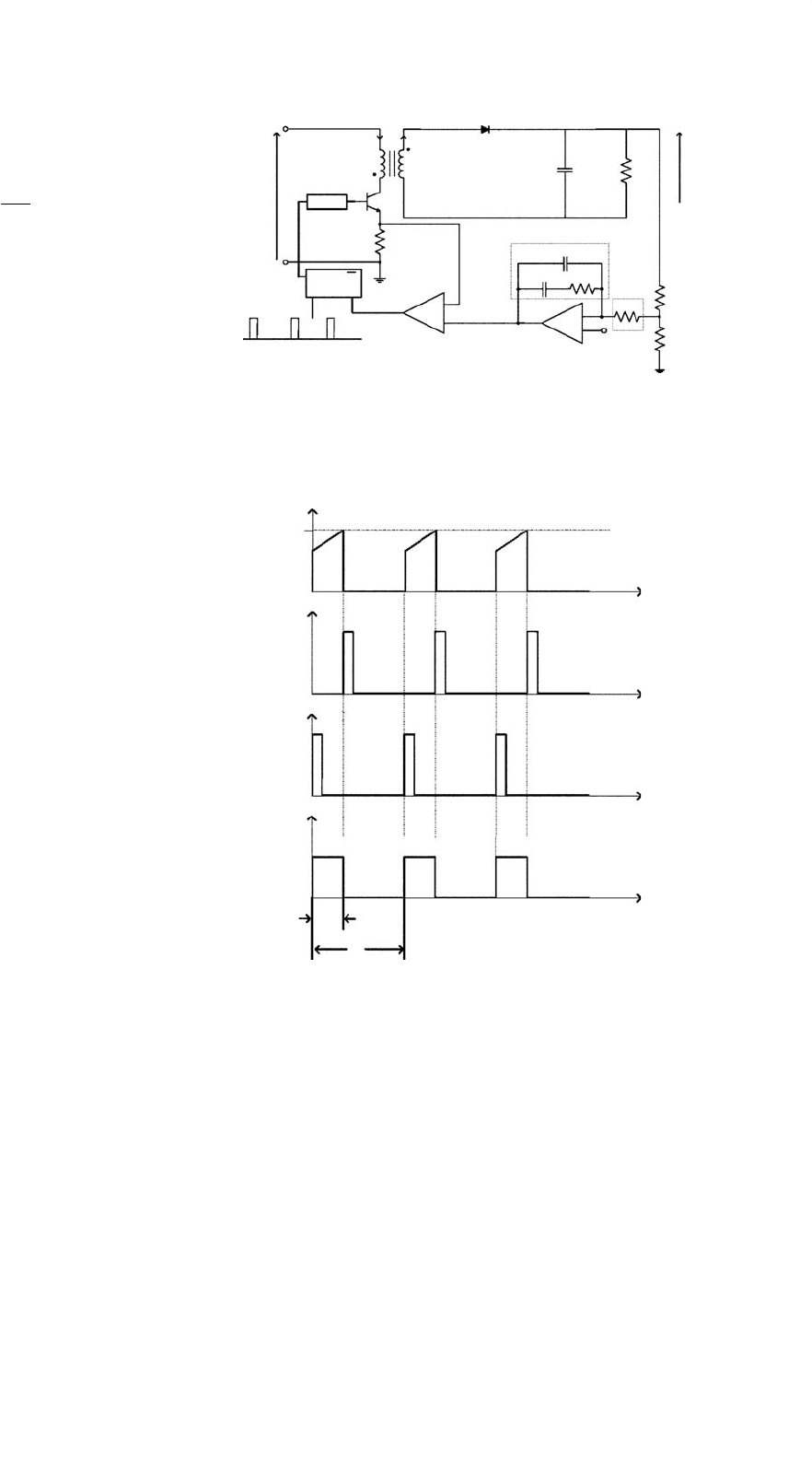
23 Power Supplies 617
Hence, the small-signal duty cycle is related to the small-
signal error voltage by
d =
v
e
V
p
(23.88)
The operation of the fixed-frequency voltage-mode con-
troller can be explained as follows. When the output is lower
than the nominal dc value, a high error voltage is produced.
This means that v
e
is positive. Hence, d is positive. The
duty cycle is increased to cause a subsequent increase in
output voltage. The feedback dynamics (stability and tran-
sient response) is determined by the operational amplifier
circuit that consists of Z
1
and Z
2
. Some of the popular
voltage-mode control ICs are SG1524/25/26/27, TL494/5, and
MC34060/63.
The current-mode control makes use of the current infor-
mation in a regulator to achieve output voltage regulation. In
its simplest form, current-mode control consists of an inner
loop that samples the inductance current value and turns the
switches off as soon as the current reaches a certain value set by
the outer voltage loop. In this way, the current-mode control
achieves faster response than the voltage mode. There are two
types of fixed-frequency PWM current-mode control, namely,
the peak current-mode control and the average current-mode
control.
In the peak current-mode control, no sawtooth generator
is needed. In fact, the inductance current waveform is itself a
sawtooth. The voltage analog of the current may be provided
by a small resistance, or by a current transformer. Also, in
practice, the switch current is used since only the positive-
going portion of the inductance current waveform is required.
Figure 23.29 shows a peak current-mode controlled flyback
regulator.
In Fig. 23.29, the regulator operates at fixed frequency. Turn
on is synchronized with the clock pulse, and turn off is deter-
mined by the instant at which the input current equals the
error voltage V
e
.
Because of its inherent peak current-limiting capability, the
peak current-mode control can enhance reliability of power
switches. The dynamic performance is improved because of the
use of the additional current information. One main disadvan-
tage of the peak current-mode control is that it is extremely
susceptible to noise, since the current ramp is usually small
compared to the reference signal. A second disadvantage
is its inherent instability property at duty cycle exceeding
50%, which results in sub-harmonic oscillation. Typically, a
compensating ramp is required at the comparator input to
eliminate this instability. The third disadvantage is that it has a
non-ideal loop response because of the use of the peak, instead
of the average current sensing.
Figure 23.30 shows an average current-mode controlled fly-
back regulator. In the circuit, a PWM modulator (instead
D
R
C
F
N
s
R
S
Z
1
Z
2
C
21
C
22
R
11
R
1
R
2
R
21
Driver
Latch
Comp
Error voltage V
e
Error amplifier
V
REF
QQ
RS
Clock
N
p
Q
1
V
i
V
Q1
I
s
I
p
V
s
+
+
+
+
−
−
−
−
R
L
V
o
(a)
I
SW
Ve
0
0
0
0
R
S,Clock
Driving signal
DT
t
t
t
t
T
(b)
FIGURE 23.29 A simplified peak current-mode controlled flyback
regulator: (a) circuit and (b) the associated waveforms.
of a clocked SR latch in the peak current-mode control)
is employed to compare the current error to an externally
generated sawtooth signal to formulate the desired control
signal. The main advantages of this method over the peak
current-control are that it has excellent noise immunity prop-
erty; it is stable at duty cycle exceeding 50%; and it provides
good tracking of average current. However, since there are
three compensation networks (Z
1
, Z
2
, and Z
3
), the analysis
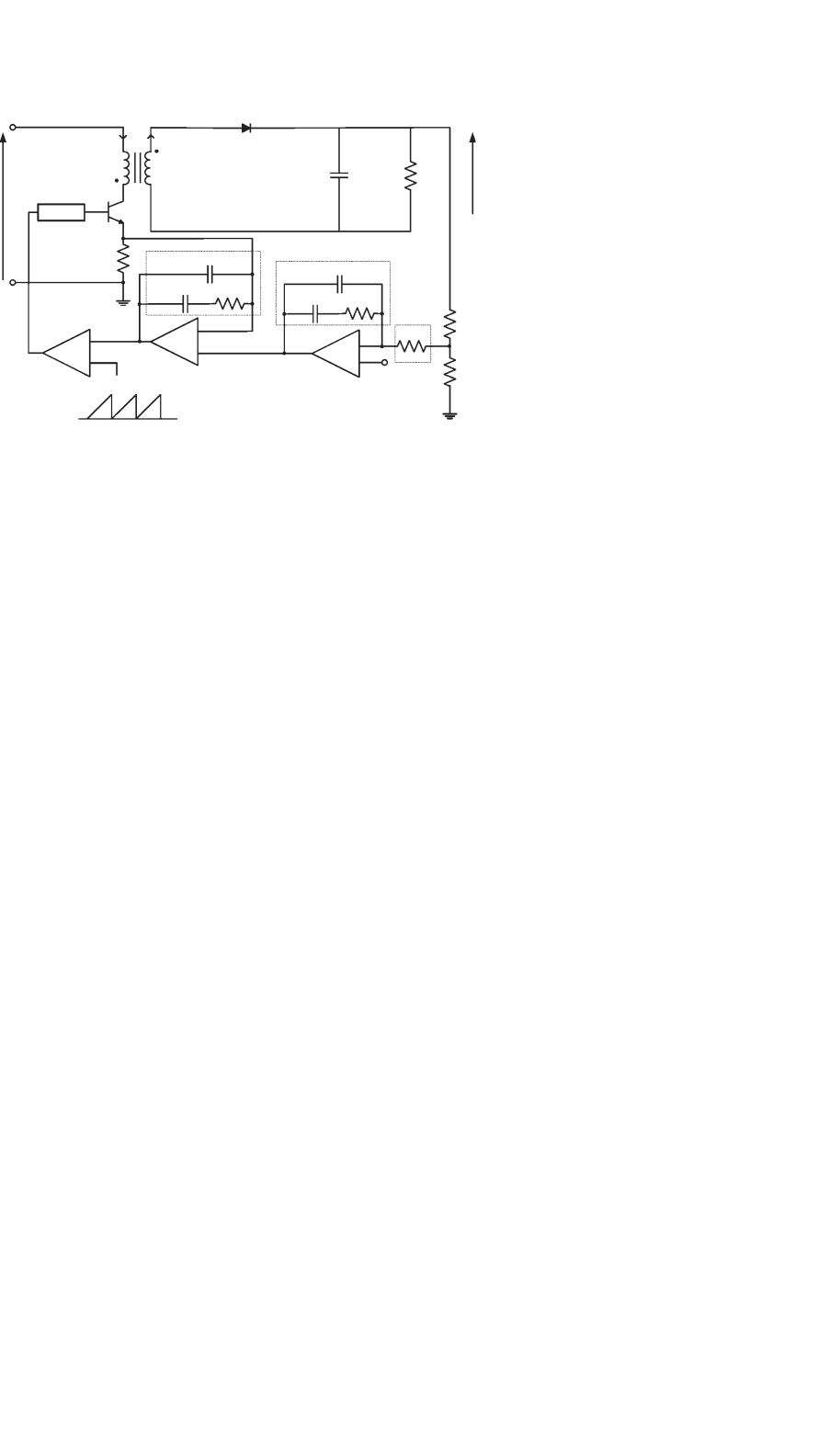
618 Y. M. Lai
R
C
F
N
s
R
S
Z
1
Z
2
Z
3
C
21
C
22
C
32
C
31
R
31
R
11
R
1
R
2
R
21
Driver
Sawtooth
PWM
Comp
Error voltage V
e
V
REF
N
p
Q
1
V
i
V
Q1
I
s
I
p
V
s
+
+
+
+
−
−
−
−
R
L
V
o
FIGURE 23.30 A simplified average current-mode controlled flyback regulator: (a) circuit and (b) the associated waveforms.
and optimal design of these networks are non-trivial. This is
a major obstacle for adopting the average current mode
control.
It should be noted that current-mode control is particu-
larly effective for the flyback and boost-type regulators that
have an inherent right-half-plane zero. Current-mode con-
trol effectively reduces the system to first-order by forcing
the inductor current to be related to the output voltage, thus
achieving faster response. In the case of the buck-type regu-
lator, current-mode control presents no significant advantage
because the current information can be derived from the out-
put voltage, and hence faster response can still be achieved
with a proper feedback network. Some of the popular current-
mode control ICs are UC3840/2, UC3825, MC34129, and
MC34065.
Further Reading
1. A.I. Pressman, Switching Power Supply Design,2
nd
ed., New York:
McGraw-Hill, 1999.
2. M. Brown, Practical Switching Power Supply Design,2
nd
ed., New York:
McGraw-Hill, 1999.
3. P.T. Krein, Elements of Power Electronics,1
st
ed., Cambridge:
Oxford University Press, 1998.
4. J.G. Kassakian, M.R. Schlecht, and G.C. Verghese, Principles of Power
Electronics,1
st
ed., MA Reading: Addison-Wesley, 1991.
5. G. Chryssis, High-Frequency Switching Power Supplies,1
st
ed.,
New York: McGraw-Hill, 1984.
6. M.H. Rashid, Power Electronics – Circuits, Devices, and Applications,
2
nd
ed., New Jersey: Prentice-Hall, 1993.
7. T.L. Floyd and D. Buchla, Fundamentals of Analog Circuits,1
st
ed.,
New Jersey: Prentice-Hall, 1999.

24
Uninterruptible Power Supplies
Adel Nasiri, Ph.D.
Power Electronics and Motor Drives
Laboratory, University of
Wisconsin-Milwaukee, 3200
North Cramer Street, Milwaukee
Wisconsin, USA
24.1 Introduction .......................................................................................... 619
24.2 Classifications ........................................................................................ 619
24.2.1 Standby UPS • 24.2.2 On-line UPS System • 24.2.3 Line-interactive UPS
• 24.2.4 Universal UPS • 24.2.5 Rotary UPS • 24.2.6 Hybrid Static/Rotary UPS
• 24.2.7 Comparison of UPS Configurations
24.3 Performance Evaluation ........................................................................... 626
24.4 Applications........................................................................................... 627
24.5 Control Techniques................................................................................. 628
24.6 Energy Storage Devices ............................................................................ 630
24.6.1 Battery • 24.6.2 Flywheel • 24.6.3 Fuel Cell
Further Reading ..................................................................................... 632
24.1 Introduction
Power distortions such as power interruptions, voltage sags
and swells, voltage spikes, and voltage harmonics can cause
severe impacts on sensitive loads in the electrical systems.
Uninterruptible power supply (UPS) systems are used to pro-
vide uninterrupted, reliable, and high quality power for these
sensitive loads. Applications of UPS systems include medical
facilities, life supporting systems, data storage and computer
systems, emergency equipment, telecommunications, indus-
trial processing, and on-line management systems [1–3]. The
UPS systems are especially required in places where power
outages and fluctuations occur frequently. A UPS provides a
backup power circuitry to supply vital systems when a power
outage occurs. In situations where short time power fluctu-
ations or disturbed voltage occur, a UPS provides constant
power to keep the important loads running. During extended
power failures, a UPS provides backup power to keep the
systems running long enough so that they can be gracefully
powered down.
Most of the UPS systems also suppress line transients and
harmonic disturbances. Generally, an ideal UPS should be
able to simultaneously deliver uninterrupted power and pro-
vide the necessary power conditioning for the particular power
application. Therefore, an ideal UPS should have the follow-
ing features: regulated sinusoidal output voltage with low total
harmonic distortion (THD) independent from the changes in
the input voltage or in the load, on-line operation that means
zero transition time from normal to back-up mode and vice
versa, low THD sinusoidal input current and unity power
factor, high reliability, high efficiency, low EMI and acous-
tic noise, electric isolation, low maintenance, low cost, weight,
and size. Obviously, there is not a single configuration that can
provide all of these features. Different configurations of UPS
systems emphasize on some of the features mentioned above.
Classifications of UPS systems are described in Section 24.2.
24.2 Classifications
24.2.1 Standby UPS
This configuration of UPS system is also known as “off-line
UPS” or “line-preferred UPS” [4, 5]. Figure 24.1 shows the
configuration of a typical standby UPS system. It consists of
an AC/DC converter, a battery bank, a DC/AC inverter, and
a static switch. A passive low pass filter may also be used at
the output of the UPS or inverter to remove the switching fre-
quency from the output voltage. The static switch is on during
the normal mode of operation. Therefore, load is supplied
from the AC line directly without any power conditioning.
At the same time, the AC/DC rectifier charges the battery set.
This converter is rated at a much lower power rating than the
power demand of the load. When a power outage occurs or
the primary power is out of a given preset tolerance, the static
switch is opened and the DC/AC inverter provides power to
Copyright © 2007, 2001, Elsevier Inc.
All rights reserved.
619
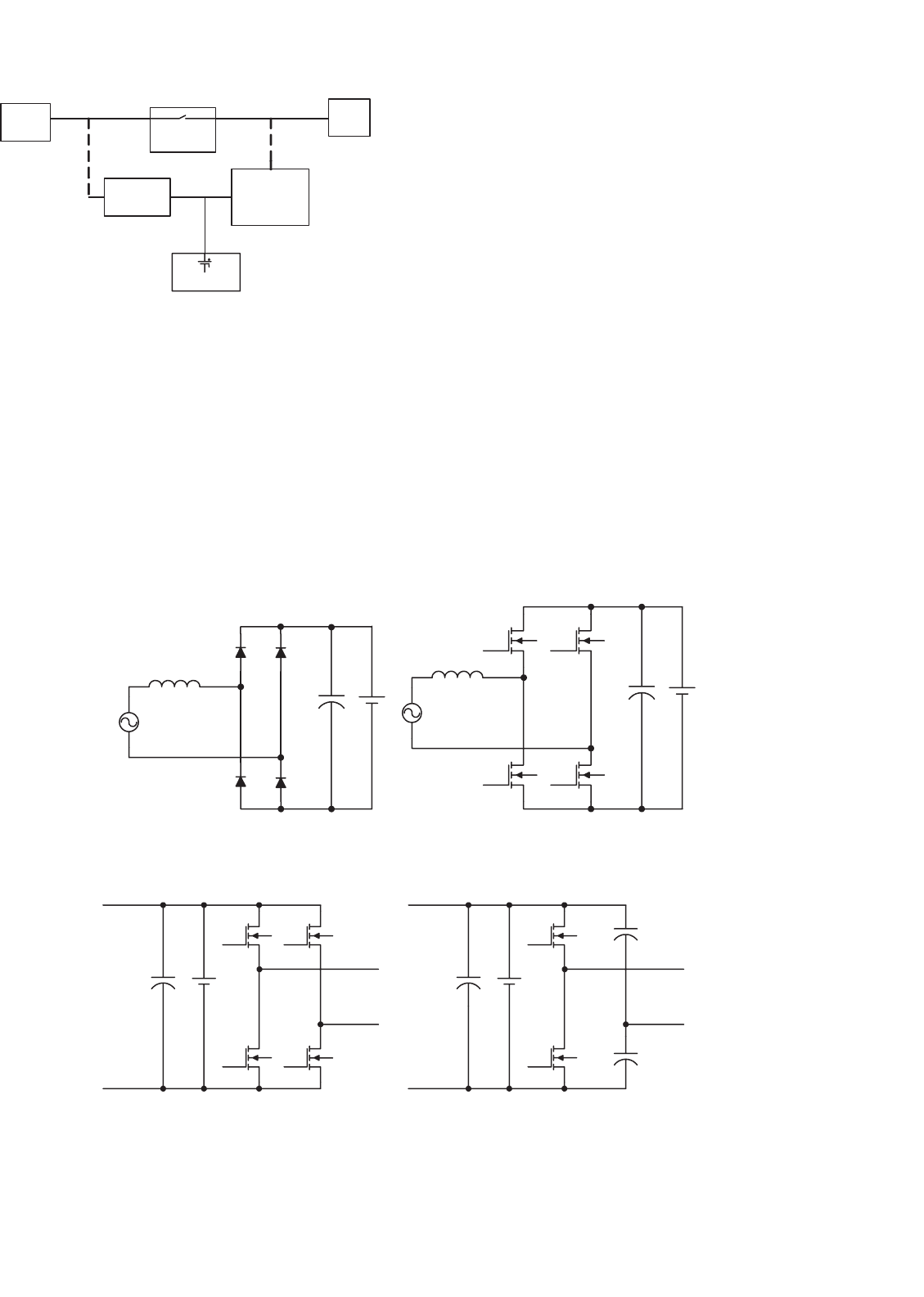
620 A. Nasiri
AC/DC
Rectifier/
Charger
DC/AC
Inverter
Static Switch
(Normally on)
AC
Line
Load
Battery Bank
FIGURE 24.1 Configuration of a typical standby UPS system.
the load from the battery set for the duration of the preset
backup time or till the AC line is back again. This inverter
is rated at 100% of the load power demand. It is connected
in parallel to the load and stays standby during the normal
mode of operation. The transition time from the AC line to
DC/AC inverter is usually about one quarter of the line cycle,
which is enough for most of the applications such as personal
computers. The main advantages of this topology are simple
design, low cost, and small size. On the other hand, lack of real
V
S
L
S
C
dc
D
1
D
3
D
2
D
4
V
S
L
S
C
dc
BatteryBattery
S
1
S
3
S
2
S
4
(a) (b)
FIGURE 24.2 Two simple topologies of AC/DC rectifier: (a) full-bridge diode rectifier and (b) full-bridge full controlled topology.
C
dc
Battery
S
1
S
3
S
2
S
4
+
_
V
dc
+
_
V
Load
C
dc
Battery
S
1
S
2
+
_
V
dc
+
_
V
Load
C
1
C
2
(a) (b)
FIGURE 24.3 Two simple single-phase topologies for the DC/AC inverter: (a) full-bridge and (b) half-bridge.
isolation of the load from the AC line, no output voltage regu-
lation, long switching time, poor performance with non-linear
loads, and no line conditioning are the main disadvantages of
this configuration.
Different configurations of AC/DC rectifiers such as linear
or switching may be used in this system. To reduce the cost, a
simple diode-bridge rectifier with a capacitor at the front end
is used. A full-bridge or half-bridge full controlled converter is
also used to charge the battery bank. Two typical topologies for
a single-phase UPS system are shown in Fig. 24.2. The full con-
trolled topologies can provide power factor correction (PFC)
to meet the corresponding standards. To optimize the charging
process, the charging cycle is divided into “constant current”
and “constant voltage” modes. In the constant current mode,
the converter injects a constant current into the battery till the
battery is charged up to about 95% of its capacity. After this
mode, the constant voltage mode starts that applies a constant
voltage on the battery. In this mode, the input current of the
battery declines exponentially until it is fully charged.
The purpose of the DC/AC inverter is to provide high qual-
ity AC power to the load when the static switch is opened.
A full- or half-bridge topology is used for this inverter.
Figure 24.3 shows two simple single-phase topologies for the
DC/AC inverter.
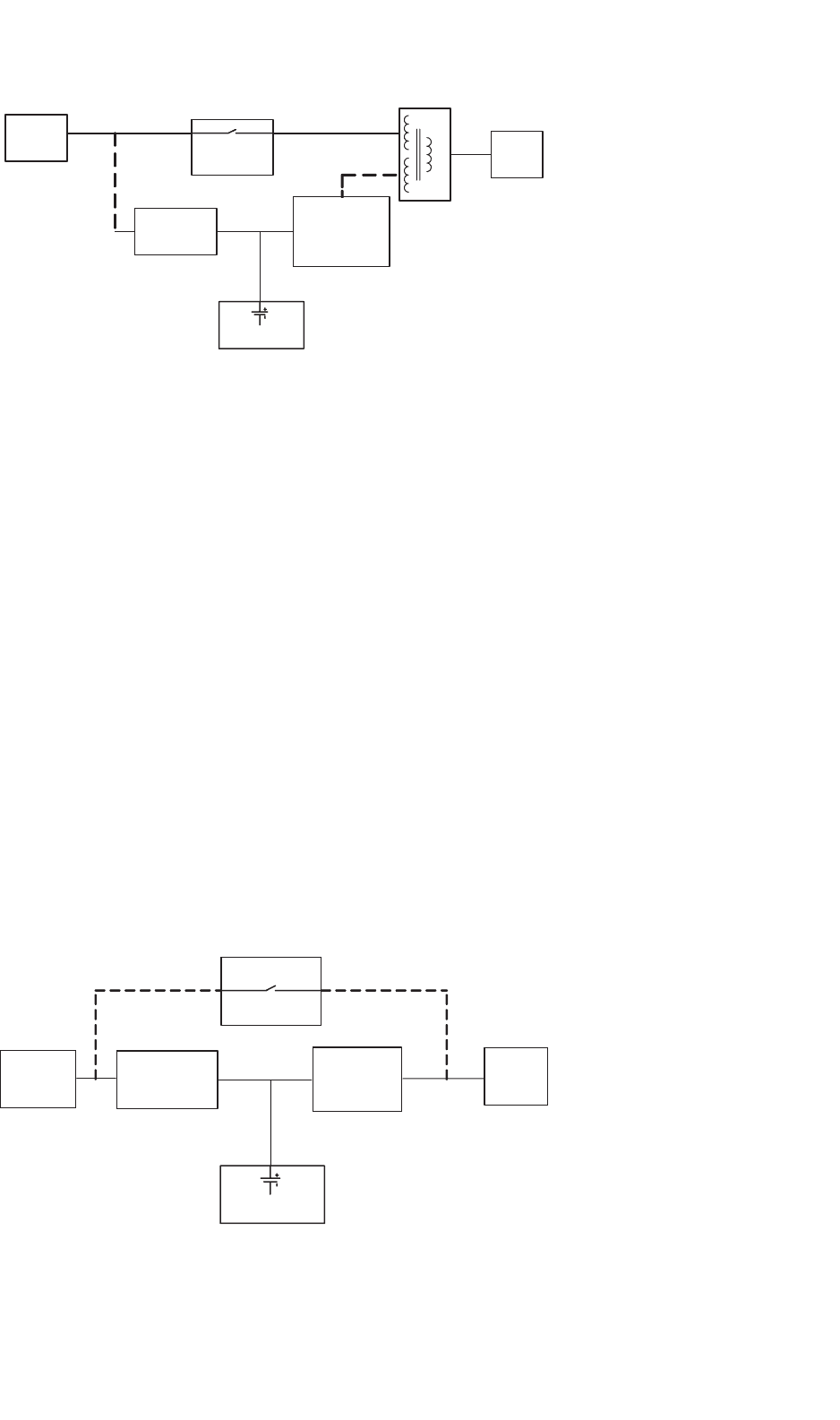
24 Uninterruptible Power Supplies 621
AC/DC
Rectifier/
Charger
DC/AC
Inverter
Static Switch
(Normally on)
AC
Line
Load
Battery Bank
FIGURE 24.4 Typical configuration of ferroresonant standby UPS system.
In some topologies of standby UPS systems, an isolating
transformer is used at the output stage of the UPS. This
topology is called ferroresonant standby UPS system. The
transformer also acts as a low pass filter that cancels out
switching frequency from the output voltage of the DC/AC
inverter. On the other hand, the transformer stores electro-
magnetic energy in the core and acts as a buffer when a power
outage occurs. For a short time, the transformer provides
power to the load and protects sensitive equipment from being
affected during the transfer time from the input AC to the UPS.
Figure 24.4 shows the configuration of a ferroresonant standby
UPS system. Since the transformer is bulky and expensive, this
configuration is more appropriate for high power applications.
24.2.2 On-line UPS System
Similar to standby UPS systems, on-line UPS systems also
consist of a rectifier/charger, a battery set, an inverter, and a
static switch (bypass). Other names for this configuration are
“true UPS,” “inverter preferred UPS,” and “double-conversion
UPS” [6, 7]. Figure 24.5 shows the block diagram of a typi-
cal on-line UPS. The rectifier/charger continuously supplies
AC/DC
Rectifier/
Charger
DC/AC
Inverter
Static Switch
(Normally off)
AC
Line
Load
Battery Bank
FIGURE 24.5 Block diagram of an on-line UPS system.
power to the DC bus. The power rating of this converter must
be designed appropriately to supply power to the load and
charge the battery bank at the same time. The batteries are
rated in order to supply full power to the load during the
backup time. The duration of this time varies in different appli-
cations. The inverter is rated at 100% of the load power since
it must supply the load during the normal mode of operation
as well as during the backup time. It is connected in series with
the load; hence, there is no transfer time associated with the
transition from normal mode to stored energy mode. This is
the main advantage of on-line UPS systems. The static switch
provides redundancy of the power source in the case of UPS
malfunction or overloading. The AC line and load voltages
must be in phase in order to use the static switch. This can
be achieved easily by a phase-locked loop control. During the
normal mode of operation, the power to the load is continu-
ously supplied via the rectifier/charger and inverter. In fact, a
double conversion from AC to DC and then from DC to AC
takes place. This configuration of the UPS allows good power
conditioning. The AC/DC converter charges the battery set
and also supplies power to the load via the inverter. There-
fore, it has the highest power rating in this topology, thereby
